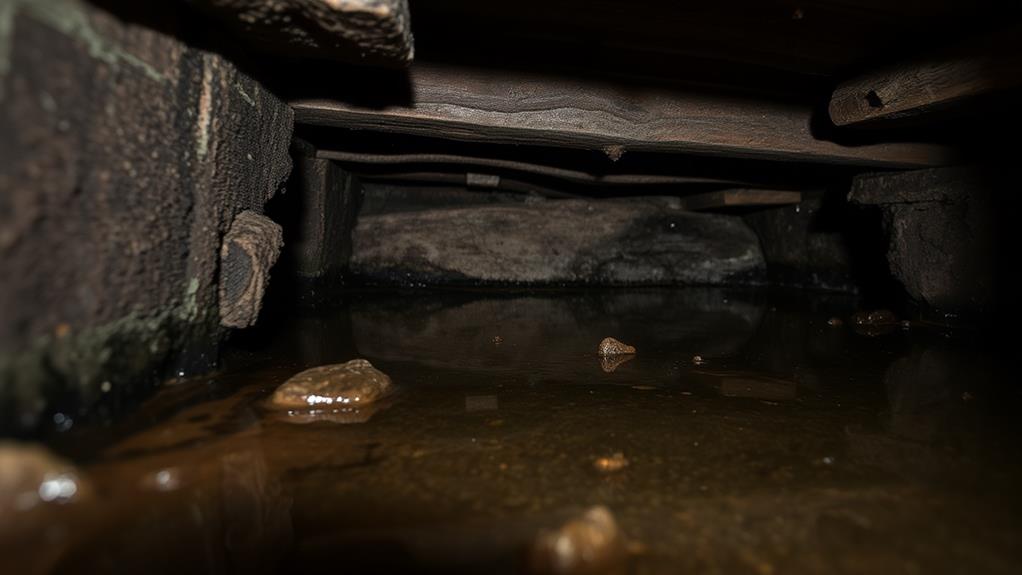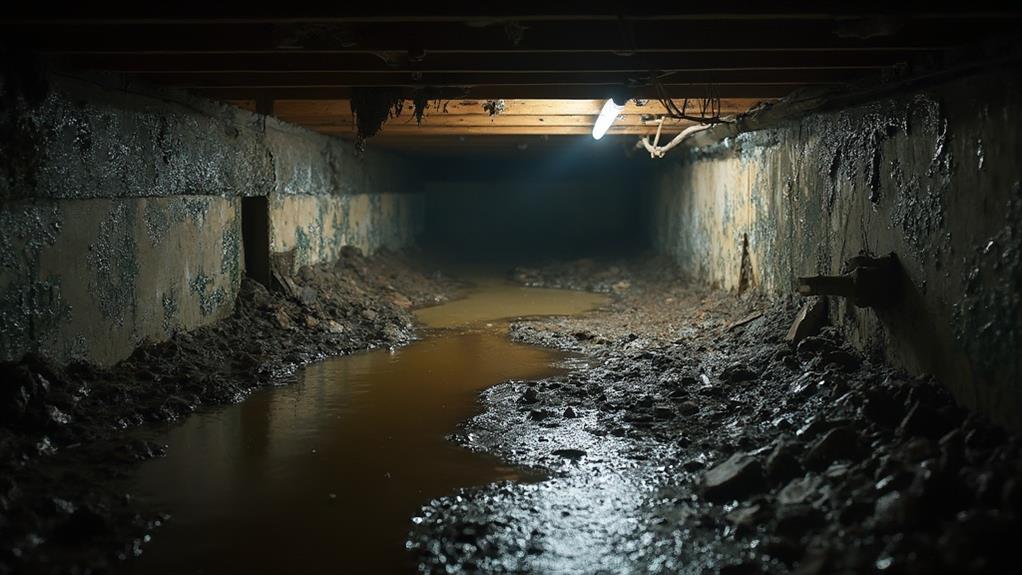Standing water in crawl spaces is a serious issue that often goes unnoticed but can lead to significant problems. It can result from poor drainage, plumbing leaks, or high humidity. Signs include musty odors, water stains, and increased indoor humidity. Left unchecked, standing water can cause structural damage to foundations, promote mold growth, and create health hazards for occupants. Risks include weakened building materials, wood rot, and respiratory issues. Addressing the problem requires identifying the water source, implementing moisture control solutions, and regular maintenance. Understanding the causes and consequences of crawl space water is crucial for protecting your home and health.
Causes of Crawl Space Water

Moisture, the silent intruder, can infiltrate crawl spaces through various means. Poor drainage around the home's foundation is a primary culprit, allowing water to seep in during heavy rains or snow melts. Improperly graded landscapes that slope towards the house rather than away from it exacerbate this issue.
Leaky plumbing, including pipes and fixtures within or above the crawl space, can contribute to water accumulation over time. High humidity levels in the surrounding environment can also lead to condensation within the crawl space, especially if it lacks proper ventilation.
In coastal or flood-prone areas, rising groundwater tables may push moisture up through the soil and into the crawl space. Cracks in the foundation walls or floor can provide entry points for water, particularly in older homes or those with settling issues.
Inadequate or damaged vapor barriers can fail to prevent ground moisture from evaporating into the crawl space. Additionally, improperly installed or maintained gutters and downspouts may direct water towards the foundation instead of away from it, leading to water intrusion in the crawl space.
Signs of Standing Water
Vigilance is key when it comes to identifying standing water in crawl spaces. Homeowners should be alert to several telltale signs that indicate the presence of moisture accumulation beneath their homes.
One of the most obvious indicators is a musty odor permeating the house, especially on the ground floor. This smell often results from mold and mildew growth in damp conditions. Visual cues include water stains or discoloration on walls, floors, or wooden structures within the crawl space. Peeling paint or wallpaper on interior walls can also suggest moisture issues below.
Increased humidity levels throughout the home, particularly in basement areas, may point to standing water problems. Condensation on windows, pipes, or ductwork is another red flag. Warped or buckled flooring, especially in rooms directly above the crawl space, can indicate prolonged exposure to moisture.
Homeowners should also be wary of sudden increases in utility bills, as standing water can impact the efficiency of HVAC systems. Regular inspections of the crawl space, checking for pooling water, wet insulation, or visible mold growth, are crucial for early detection and prevention of further damage.
Structural Damage Risks

The integrity of a home's foundation is at risk when standing water persists in crawl spaces. Prolonged exposure to moisture can weaken concrete and masonry, leading to cracks, erosion, and eventual structural instability.
Wood components, such as floor joists and support beams, are particularly vulnerable to water damage. They can rot, warp, or become infested with wood-destroying organisms, compromising the overall stability of the house.
Standing water also increases hydrostatic pressure against foundation walls, potentially causing them to bow, crack, or shift. This pressure can force water through tiny fissures, exacerbating the problem and leading to more severe structural issues over time.
Additionally, the excess moisture can corrode metal fasteners, nails, and other hardware essential for maintaining the integrity of the structure.
The weight of saturated soil around the foundation can cause settling or heaving, resulting in uneven floors, stuck doors, and cracks in walls and ceilings. In extreme cases, significant structural damage may necessitate costly repairs or even render the home uninhabitable.
Regular inspection and prompt addressing of standing water issues are crucial to prevent these potentially devastating consequences.
Health Hazards and Mold Growth
Standing water in crawl spaces poses significant health risks to occupants of the home. The damp environment creates ideal conditions for mold and mildew growth, which can release spores into the air and circulate throughout the house. These spores can trigger allergic reactions, respiratory issues, and exacerbate existing conditions such as asthma. Moreover, prolonged exposure to mold can lead to more severe health problems, including chronic lung illnesses and immune system disorders.
The stagnant water also attracts pests like mosquitoes, which can breed in small amounts of standing water and potentially transmit diseases. Additionally, the increased humidity from standing water can cause wood rot, attracting wood-destroying insects such as termites and carpenter ants. These pests not only compromise the structural integrity of the home but can also pose health risks through their droppings and the allergens they produce.
Furthermore, standing water can lead to the growth of harmful bacteria and microorganisms, which can contaminate the air quality in the home. This contamination may result in various health issues, ranging from mild respiratory irritation to more serious infections, particularly in individuals with compromised immune systems.
Moisture Control Solutions

Effectively managing moisture in crawl spaces is crucial for preventing standing water and its associated problems. Several moisture control solutions can be implemented to address this issue. Installing a vapor barrier is a primary step, involving the placement of a thick polyethylene sheet over the crawl space floor to block moisture from the soil.
Proper grading around the home's foundation and maintaining functional gutters and downspouts help divert water away from the crawl space. Adequate ventilation is essential for moisture control. Installing vents or a dehumidification system can help regulate humidity levels. In severe cases, a sump pump may be necessary to remove accumulated water.
Sealing any cracks or gaps in the foundation walls and ensuring proper insulation can further prevent moisture intrusion. Regular inspections and maintenance are crucial for long-term moisture control. This includes checking for leaks in plumbing or HVAC systems, monitoring humidity levels, and promptly addressing any signs of water accumulation.
In some cases, professional waterproofing services may be required to implement comprehensive moisture control solutions tailored to the specific needs of the crawl space and surrounding environment.
Professional Inspection and Assessment
For accurate diagnosis and effective treatment of standing water issues in crawl spaces, professional inspection and assessment are indispensable. Certified professionals possess the expertise and specialized equipment necessary to identify the root causes of moisture problems and recommend appropriate solutions.
During an inspection, experts thoroughly examine the crawl space, checking for water intrusion points, assessing the extent of damage, and evaluating existing moisture control measures. Inspectors use moisture meters, infrared cameras, and hygrometers to detect hidden moisture and measure relative humidity levels. They also assess the structural integrity of the foundation, looking for signs of settlement, cracks, or other issues that may contribute to water infiltration. The inspection process includes evaluating the effectiveness of existing drainage systems, gutters, and downspouts.
Following the assessment, professionals provide detailed reports outlining their findings and recommendations. These reports typically include photographic evidence, moisture level readings, and prioritized action plans for addressing identified issues. Professional assessments not only help homeowners understand the scope of the problem but also provide valuable documentation for insurance claims or potential legal matters related to water damage.
DIY Prevention Techniques

While professional assessment is invaluable, homeowners can implement several DIY prevention techniques to mitigate standing water issues in crawl spaces. Regular inspections are crucial; check for signs of moisture, mold, or water damage every few months.
Ensure proper grading around the house's foundation, sloping away from the structure to direct water runoff. Clean and maintain gutters and downspouts, extending them at least 5 feet from the foundation.
Install a vapor barrier on the crawl space floor, using heavy-duty polyethylene sheeting to prevent ground moisture from seeping upward. Seal any cracks or gaps in the foundation walls with hydraulic cement or masonry caulk. Improve ventilation by installing vents or a dehumidifier to control humidity levels. Consider adding a sump pump in low-lying areas prone to water accumulation.
Insulate water pipes to prevent condensation and potential leaks. Trim vegetation near the foundation to reduce moisture retention. Finally, monitor indoor humidity levels and use exhaust fans in bathrooms and kitchens to minimize moisture buildup. These preventive measures can significantly reduce the risk of standing water in crawl spaces, protecting your home's structural integrity and indoor air quality.
Long-Term Maintenance Strategies
To maintain a dry crawl space over the long term, homeowners must adopt a proactive approach that combines regular inspections with ongoing preventive measures. Establishing a routine inspection schedule, typically bi-annually, allows for early detection of potential issues. During these inspections, check for signs of moisture intrusion, mold growth, pest infestations, and structural damage.
Implement a comprehensive maintenance plan that includes regular cleaning and debris removal from the crawl space. Ensure proper ventilation by keeping vents clear and functional. Monitor and maintain gutters and downspouts to direct water away from the foundation. Consider installing a permanent dehumidification system to control moisture levels consistently.
Periodically review and update waterproofing measures, such as vapor barriers and foundation sealants. Address any cracks or deterioration in the foundation promptly. Maintain proper grading around the home's exterior to prevent water from pooling near the foundation. Regularly trim vegetation near the foundation to reduce moisture retention and potential root intrusion.
Educate family members about the importance of crawl space maintenance and establish protocols for promptly reporting any observed issues. By consistently implementing these long-term strategies, homeowners can significantly reduce the risk of standing water and associated problems in their crawl spaces.
Frequently Asked Questions
Can Standing Water in Crawl Spaces Affect My Home's Resale Value?
Standing water in crawl spaces can significantly impact a home's resale value. It indicates potential structural issues, mold growth, and moisture-related problems. Prospective buyers may be deterred, leading to lower offers or difficulty selling the property altogether.
How Often Should I Check My Crawl Space for Standing Water?
Experts recommend inspecting your crawl space for standing water at least twice a year, ideally during spring and fall. However, if you live in an area prone to heavy rainfall or flooding, more frequent checks may be necessary to prevent potential issues.
Are There Any Government Regulations Concerning Crawl Space Moisture Levels?
In California, Title 24 energy efficiency standards address crawl space moisture. Generally, there are no specific federal regulations on crawl space moisture levels. However, local building codes may include requirements for vapor barriers and ventilation to control moisture.
Can Standing Water in Crawl Spaces Attract Pests Other Than Mold?
Standing water in crawl spaces can indeed attract various pests beyond mold. This moist environment is appealing to insects like termites, carpenter ants, and mosquitoes. Additionally, it may draw rodents seeking water sources, potentially leading to infestations.
Is It Possible to Convert a Damp Crawl Space Into Usable Living Space?
Converting crawl spaces can be challenging. Comprehensive cleanup and careful construction are crucial. Proper waterproofing, insulation, ventilation, and compliance with local building codes are essential. Professional assessment and extensive renovations are typically required to create a habitable living space.
Conclusion
Standing water in crawl spaces poses significant risks to both structural integrity and occupant health. Vigilant monitoring, proactive moisture control, and regular maintenance are paramount in preventing water accumulation and its deleterious effects. Professional assessment, coupled with judicious implementation of prevention techniques, can safeguard against the insidious spread of mold and miasma. Homeowners must remain cognizant of this often-overlooked area, as neglect may lead to costly repairs and potential health hazards. Addressing crawl space moisture is an investment in long-term home preservation and inhabitant well-being.

